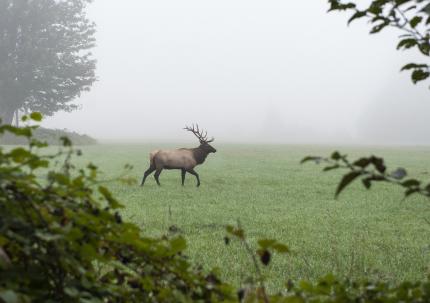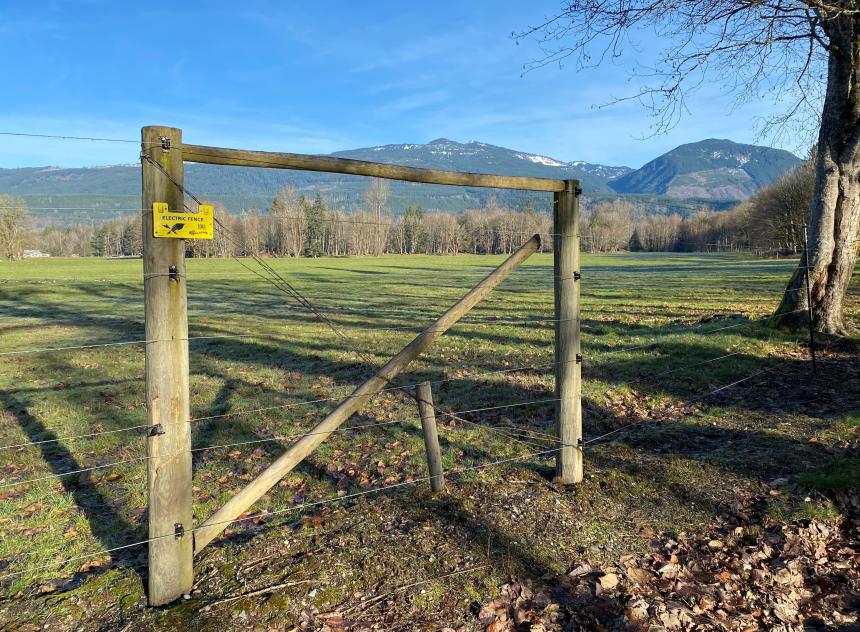The North Cascades Elk (Cervus canadensis) Herd (NCEH) is the smallest of ten herds formally recognized and managed by the Washington Department of Fish and Wildlife (WDFW) and is the northernmost elk herd in western Washington. The herd resides in the Skagit, Nooksack, Samish, and Sauk river watersheds of Skagit and Whatcom counties.

The herd is co-managed with the Point Elliott Treaty Tribes. Despite the herd’s relatively small size, it is an important resource providing recreational, aesthetic, and economic benefits to Washington residents. Tribal Co-managers value this elk herd as a significant cultural, subsistence, and ceremonial resource.
While hunting can be very challenging due to access constraints, special permit hunting opportunities in Game Management Units (GMU) 418 and 437 are prized by recreational hunters, typically requiring many years of application to draw.
Learn about elk hunting regulations and seasons on this webpage. Or learn about tribal hunting, including a co-management agreement (PDF) with the Point Eliott Treaty Tribes.
Management Summary
For many years, WDFW has contributed significant effort and resources to assist property owners with managing and preventing human-wildlife conflict issues. In areas the North Cascades elk herd frequents, WDFW staff have partnered with local landowners, Tribal Co-managers, non-governmental organizations, and others to mitigate human-elk conflicts in the Skagit Valley and nearby areas.
Our objective is to reduce negative impacts and costs landowners, agriculture, and local communities incur, while respecting that elk are native to the North Cascades region, including the Skagit and Nooksack watersheds—naturally inhabit valley bottoms, especially during winter months—and are of significant value for hunters, wildlife enthusiasts, Tribal Co-managers, and many other Washingtonians.
WDFW has funded full-time wildlife conflict staff to provide expert support and field assistance, assist landowners with fencing materials and installation, reimburse commercial producers for the costs of fertilizer, seed, and noxious weed control in areas disturbed by elk; offer hazing and other deterrents, deploy Master Hunters to properties where elk damage is greatest, and provide landowners with authority to remove elk using Damage and Kill Permits.
We continually seek the appropriate balance between elk conflict management and conservation and are committed to working collaboratively with landowners, Tribal Co-managers, and others in this community.

Elk herd population objective
WDFW and Tribal Co-managers conduct aerial surveys of the North Cascades Elk Herd (NCEH). The population estimate from the 2023 survey was 1,621 elk. The population objective from the 2018 herd plan is 1,700 - 2,000 elk.
Refer to the following links for additional updates and survey reports.
Updates and presentations
The following are updates, plans, letters, and reports related to the North Cascades Elk Herd.
- North Cascades Elk Herd Management Summary (2024)
- North Cascades Elk Herd Population Surveys (PDF) (June 2023)
- North Cascades Elk Herd Management Summary (PDF) (2023)
- Presentation to Fish and Wildlife Commission: Elk Management in Skagit and Whatcom Counties (PDF) (April 2023)
- WDFW Director's response to Skagit County Commissioners' letter (PDF) (February 2023)
- 2022 Game Status and Trend Report (see page 119 for North Cascades Elk Herd)
- North Cascades Elk Herd Management Summary (2022)
- Washington State Elk Herd Plan: North Cascade (Nooksack) Elk Herd (2018)
Monthly Damage Reports
Monthly Damage Reports from WDFW's Skagit County Conflict Specialist.
- North Cascades Elk Herd Damage Update for April 2025 (PDF)
- North Cascades Elk Herd Damage Update for March 2025 (PDF)
- North Cascades Elk Herd Damage Update for Feb. 2025 (PDF)
- North Cascades Elk Herd Damage Update for Jan. 2025 (PDF)
- North Cascades Elk Herd Damage Update for Dec. 2024 (PDF)
- North Cascades Elk Herd Damage Update for Nov. 2024 (PDF)
- North Cascades Elk Herd Damage Update for Oct. 2024 (PDF)
- North Cascades Elk Herd Damage Update for Sept. 2024 (PDF)
- North Cascades Elk Herd Damage Update for Aug. 2024 (PDF)
- North Cascades Elk Herd Damage Update for July 2024 (PDF)
- North Cascades Elk Herd Damage Update for April 2024 (PDF)
- North Cascades Elk Herd Damage Update for March 2024 (PDF)
- North Cascades Elk Herd Damage Update for Feb. 2024 (PDF)
- North Cascades Elk Herd Damage Update for Jan. 2024 (PDF)
- North Cascades Elk Herd Damage Update for Dec. 2023 (PDF)
- North Cascades Elk Herd Damage Update for Nov. 2023 (PDF)
- North Cascades Elk Herd Damage Update for Oct. 2023 (PDF)
- North Cascades Elk Herd Damage Update for June 2023 (PDF)
- North Cascades Elk Herd Damage Update for May 2023 (PDF)
- North Cascades Elk Herd Damage Update for April 2023 (PDF)
- North Cascades Elk Herd Damage Update for March 2023 (PDF)